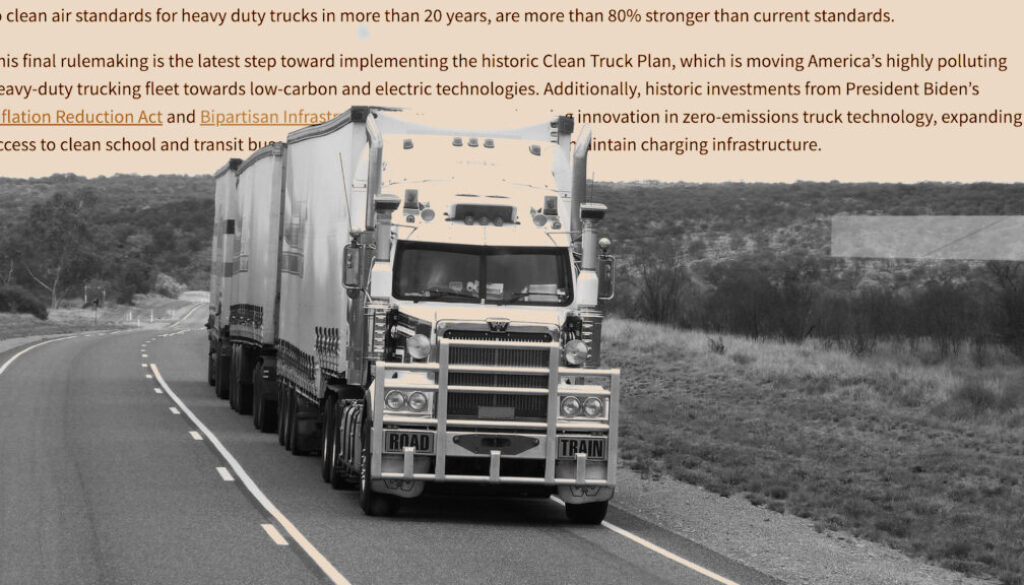Updated clean air standards to cut smog-forming truck emissions
This week, the Environmental Protection Agency (EPA) updated its clean air standards for heavy-duty vehicles for the first time in more than 20 years.
The updated standards, which will go into effect in 2027, are designed to reduce nitrogen oxide (NOx) emissions from the tailpipes of large trucks. NOx reacts with other compounds in the air to form ozone pollution, contributing to more than 60,000 deaths in the US each year. The new standards are about 80% stronger than those they replace.
The December 20 announcement came the same day the US Postal Service revealed a five-year plan to transition towards using electric delivery vehicles.
Improving public health
The EPA estimates that by 2045, the updated clean air standards will result in up to 2,900 fewer premature deaths, 6,700 fewer hospital and emergency room visits, and 18,000 fewer cases of childhood asthma each year.
“EPA is taking significant action to protect public health, especially the health of 72 million people living near truck freight routes in America, including our most vulnerable populations in historically overburdened communities,” said EPA Administrator Michael S. Regan in a press release on Tuesday.
The rule will also require emissions warranties that are 2.8 to 4.5 longer than those currently in place, meaning trucks will need to meet emissions standards for a greater period of time as they age. Additionally, companies will be required to test trucks and send data to the EPA annually, and the EPA will pull trucks from the road and test them to see if they meet the standards.
“We know in the past companies were meeting the standards when they were certifying the new trucks in the laboratory, but when the trucks were in real-world conditions, they were emitting more pollution,” said Margo Oge, former director of EPA’s Office of Transportation and Air Quality. “Twenty years ago, we attempted to fix that, but this rule is significantly better to ensure that we are going to get the public health benefits.”
Clean Trucks Plan
The announcement is the first step in the agency’s Clean Trucks Plan. In early 2023, EPA is expected to release proposals for a standard for light- and medium-duty vehicles that covers several pollutants, as well as greenhouse gas standards for heavy-duty vehicles. Oge said the goal of these greenhouse gas standards will be “to move the industry towards zero-emission trucks,” requiring companies to make substantial investments in electric vehicles or trucks powered by hydrogen fuel cells.
“EPA’s Clean Trucks Plan includes a series of vitally important steps to help ensure cleaner air and a safer climate for millions of people, save truckers and fleets money, and create more American jobs,” said Vickie Patton, General Counsel for Environmental Defense Fund, in a statement.
But Dave Cooke, Senior Vehicles Analyst for the Union of Concerned Scientists, said the standards announced this week do not go far enough. He also expressed concern that the agency is waiting until the new year to propose a zero-emissions rule.
“Unfortunately, [the rule] falls short of what states are already doing,” Cooke wrote in a blog post. “Perhaps most importantly, this rule doesn’t even attempt to grapple with the question of how to eliminate emissions from trucks, focusing exclusively on fossil-fuel powered engines to the exclusion of electrification. In punting to next year a rulemaking that could electrify the freight sector, EPA has ignored the desperate requests of the communities currently burdened by freight pollution.”
“While the rule finalized [Tuesday] will no doubt reduce emissions from the fossil-fuel-powered fleet in much of the country, it is a missed opportunity,” he wrote.
Industry pushback
Oge said that while there has been a lot of pushback by truck engine manufacturers against tighter emissions standards, this week’s announcement received the best reception she could have hoped for from the industry.
“I was pretty pleased to see the reaction of the industry was not, ‘not under my dead body,’” she said. “It was, ‘it’s going to be challenging to be met,’ but they’re going to do it. That’s good news.”
However, Oge sees greater industry challenges to greenhouse gas standards that will require manufacturers to move away from diesel engines and to embrace zero-emissions technologies.
“Publicly, they’re making these announcements, but privately they have been pushing the agency and California to do something not as ambitious,” she said. “The industry is going to have to decide, do they want to fight the government or do they want to work with both California and EPA.”
 EWG
EWG


